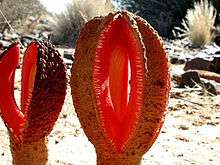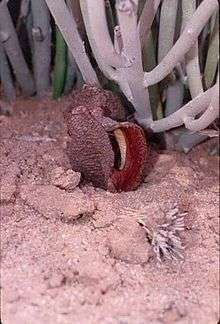Hydnora africana
| Hydnora africana | |
|---|---|
 | |
| Hydnora africana flowers, Karasburg Constituency, Namibia, 2002 | |
| Scientific classification | |
| Kingdom: | Plantae |
| Clade: | Angiosperms |
| Clade: | Magnoliids |
| Order: | Piperales |
| Family: | Aristolochiaceae |
| Genus: | Hydnora |
| Species: | H. africana |
| Binomial name | |
| Hydnora africana Thunb. | |
Hydnora africana is an achlorophyllous plant in the family Hydnoraceae, native to southern Africa that is parasitic on the roots of members of the Euphorbiaceae family.[1] The plant grows underground, except for a fleshy flower that emerges above ground and emits an odor of feces to attract its natural pollinators, dung beetles and carrion beetles.[2] The flowers act as temporary traps, retaining the beetles that enter long enough for them to pick up pollen.[3] It is also called jakkalskos or jackal food. The genus name comes from the Greek word hydnon, which translates to "truffle," and the specific epithet africana means to be from Africa.[4]
Description
Morphology
These plants do not have chlorophyll and do not perform photosynthesis. They obtain their nutrients from a host plant, such as a species of Euphorbia. Hydnora africana has an enzyme which allows it to dissolve some of the roots of its host plants in order to attach to them. Hydnora africana attaches to the roots of the host and takes some of the nutrients that it makes from photosynthesis.[5] It has a fleshy peachy-orange flower that emerges from the ground after a heavy rainfall.[4] Insects that pollinate the flowers do so by burying themselves in the sepals of the flowers through the very strong fibers that hold the sepals together. After the insects have been in the flowers for a couple of days, the flower emerges and opens releasing the insects to spread the pollen to other flowers in the area.[5]
Fruit
H. africana produces a fruit that grows underground, taking up to two years to ripen fully. The fruit is similar in taste and texture to a potato. Among other uses, it is used for tanning and preserving fishnets, because it is an astringent.[4] Each fruit produces about twenty thousand seeds. The fruit may be up to about eight centimeters in diameter.[6] Animals using the fruit as a source of food include, but are not limited to, birds, smaller animals, jackals, porcupines, and moles.
Smell
Hydnora africana has a very strong and unpleasant smell. This smell is generated from the osmophores, which is a white spongy area in the inner surface of the tepals that eventually changes color to grey. Osmophores were first called "bait bodies" by Harmes.[7] Burger et al. concluded that the odor is made up of dimethyl disulfide and dimethyl trisulfide. These odors are also found in dead-horse arum, Helicodiceros muscivorus.[7]
Reproduction
Seeds from Hydnora africana were brought back to the United States from Africa and planted in pots of Euphorbia. A flower of Hydnora africana first appeared five and a half years after the initial sowing.[8]

References
- ↑ http://botany.org/Parasitic_Plants/Hydnora_africana.php Botanical Society of America: Hydnora africana
- ↑ Waser, Nickoloas Merritt; Ollerton, Jeff, eds. (2006). "Table 6.1: Angiosperms with rewardless flowers". Plant-Pollinator Interactions: From Specialization to Generalization. University of Chicago Press. pp. 126–9. ISBN 978-0-226-87400-5.
- ↑ "BSA Parasitic Plant Pages- Hydnora Africana". Botanical Society of America. Archived from the original on 4 June 2013. Retrieved 9 June 2013.
- 1 2 3 Voigt, Werner. "Hydnora africana".
- 1 2 Campbell, Dana. "Jackal Food (Hydnora africana)". Encyclopedia of Life. Retrieved 28 October 2014.
- ↑ "Hydnoraceae-Description".
- 1 2 Bolin, Jay F. Pollination Biology Of Hydnora Africana Thunb. (Hydnoraceae) In Namibia: Brood-Site Mimicry With Insect Imprisonment.
- ↑ "The Genus Hydnora". Parasitic Plants.